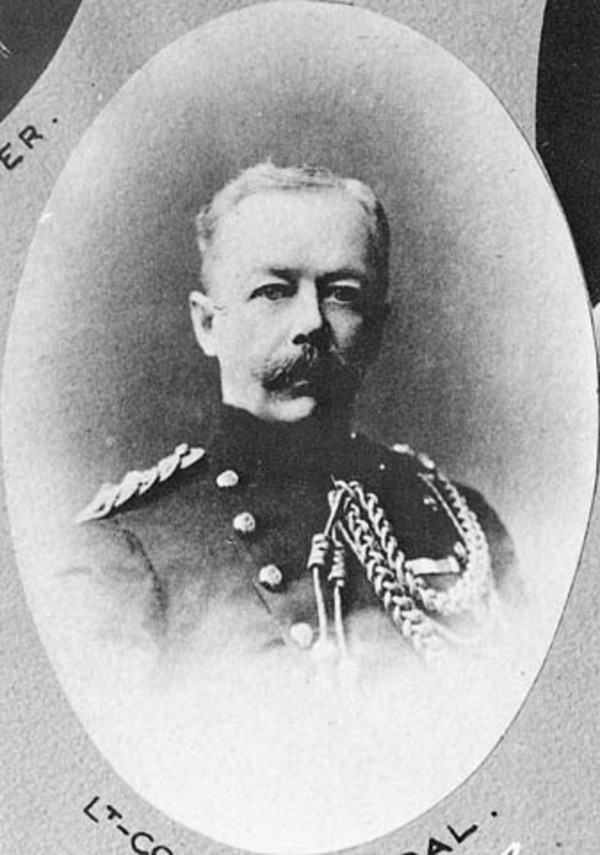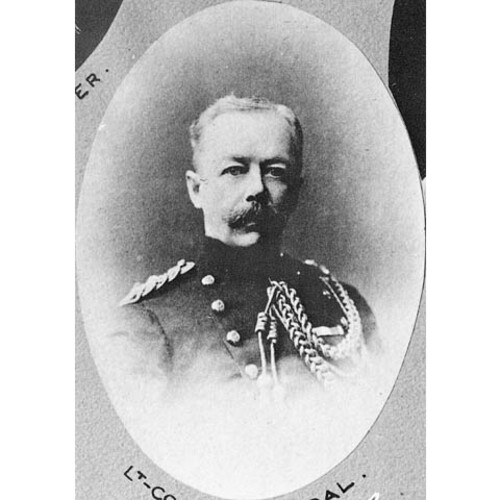VIDAL, BEAUFORT HENRY (Henri), army and militia officer; b. 16 May 1843 in Chatham, England, son of Captain Alexander Thomas Emeric Vidal and Sarah Antoinette Veitch; m. first January 1869 Kate Allen (d. 1884), and they had two children; m. secondly 2 Feb. 1892 Béatrice-Hermine Taschereau, daughter of Henri-Thomas Taschereau; they had no children; d. 2 March 1908 in Ottawa.
Beaufort Henry Vidal and his brother accompanied their father to Upper Canada in 1850 when he went to settle on lands he had acquired along the St Clair River. Educated by a tutor and at a school in Weston (Toronto), Vidal began to study law in 1860 and the same year was commissioned in the 3rd Battalion of Lambton militia. Three years later he joined the British army as an ensign in the 2nd West India Regiment, and he was promoted lieutenant in the 4th Foot on 16 Aug. 1864. His regiment saw service in the Mediterranean and in India before being called to Ethiopia in late 1867 to take part in the punitive expedition against Emperor Tewodros II, who had taken British subjects hostage. Vidal served through this arduous but not very dangerous campaign, which ended with Tewodros’s suicide in April 1868.
On his return to Canada in 1870, Vidal resumed his legal studies, and he was called to the Ontario bar in 1872. Although he had rejoined the militia in 1870, he was not active in it until 1877, by which time he was living in Toronto. There he transferred to the 12th Battalion of Infantry (York Rangers), in which he was promoted major on 12 March 1882.
For years the British authorities had been pressing Canadian governments to create a small standing army, and in 1883 the administration of Sir John A. Macdonald* finally sanctioned the formation of companies of regular infantry and cavalry. At the same time, because of public opposition to a standing army it took care to announce that these units would serve primarily as training schools for the volunteer militia. Furthermore, instead of accepting the list of officers proposed by Major-General Richard George Amherst Luard*, the British officer commanding the militia, Adolphe-Philippe Caron, the minister of militia and defence, chose to reward political supporters and friends. Of the twenty-one officers appointed, nine were without previous military service and three had had poor records in the militia.
The appointment of Vidal, a loyal Conservative, as a captain in the Infantry School Corps did not attract the criticism that had greeted a number of the other nominations, because of his experience in the British army. However, neither his experience nor his political connections were of great help in assisting his career in the fledgling Canadian army. The school companies were so small and the officers’ retirement age of 65 was so generous that there was scarcely any turnover at the top and thus no opportunity for rapid advancement. Vidal’s promotions to major in 1893 and lieutenant-colonel in 1895, and his appointment as commanding officer of the infantry company at Saint-Jean (Saint-Jean-sur-Richelieu), Que., in 1897, occurred because of his seniority.
Fate kept Vidal from seeing active service. His company was not selected to help suppress the North-West rebellion of 1885 [see Louis Riel*], and his appointment to Fredericton in 1898 as officer commanding Military District No.8 meant that he could not join the Yukon Field Force or accompany his own unit (now the Royal Canadian Regiment of Infantry) to South Africa the next year. For a while, however, he commanded the 3rd (Special Service) battalion of the RCRI, raised in 1900 to garrison Halifax in order that the British battalion there could go to South Africa.
In 1901 Vidal was transferred to militia headquarters in Ottawa as deputy adjutant general and on 1 Nov. 1904 he became adjutant general, the senior administrative officer. That these promotions occurred during the Liberal regime of Sir Wilfrid Laurier* reflects the determination of the minister of militia, Sir Frederick William Borden*, to reduce the influence of politics and patronage in the administration of the regular forces.
On 1 April 1907 Vidal was named inspector general. In Britain the post was reserved for experienced senior officers, who, placed outside the formal chain of command, were theoretically free to offer independent and objective advice and information on the army’s efficiency and readiness for war. In Vidal’s case, however, as in that of his predecessor, Lord Aylmer, the appointment and the accompanying promotion to brigadier-general were rewards for long and faithful service. Borden took his advice from the highly respected chief of the general staff, Major-General Percy Henry Noel Lake*, a British officer who discounted Vidal’s over-kind and optimistic opinions on the readiness of the militia for war. Vidal died of a heart attack in Ottawa less than a year after his promotion.
NA, MG 27, I, D3; MG 30, E242; RG 9, II. Can., Dept. of Militia and Defence, Annual report (Ottawa), 1883–86, 1897–99, 1901–2; Militia list (Ottawa), 1870, 1873, 1876–77, 1880–1907. Canadian album (Cochrane and Hopkins). Cyclopædia of Canadian biog. (Rose and Charlesworth), vol.2. R. C. Fetherstonhaugh and G. R. Stevens, The Royal Canadian Regiment . . . (2v., Montreal and London, Ont., 1936–67; vol.1 repr. Fredericton, 1981), 1. S. J. Harris, Canadian brass: the making of a professional army, 1860–1939 (Toronto, 1988). Desmond Morton, The Canadian general: Sir William Otter (Toronto, 1974); Ministers and generals: politics and the Canadian militia, 1868–1904 (Toronto and Buffalo, N.Y., 1970).
Cite This Article
Stephen J. Harris, “VIDAL, BEAUFORT HENRY (Henri),” in Dictionary of Canadian Biography, vol. 13, University of Toronto/Université Laval, 2003–, accessed April 27, 2025, https://www.biographi.ca/en/bio/vidal_beaufort_henry_13E.html.
The citation above shows the format for footnotes and endnotes according to the Chicago manual of style (16th edition). Information to be used in other citation formats:
| Permalink: | https://www.biographi.ca/en/bio/vidal_beaufort_henry_13E.html |
| Author of Article: | Stephen J. Harris |
| Title of Article: | VIDAL, BEAUFORT HENRY (Henri) |
| Publication Name: | Dictionary of Canadian Biography, vol. 13 |
| Publisher: | University of Toronto/Université Laval |
| Year of revision: | 1994 |
| Access Date: | April 27, 2025 |




